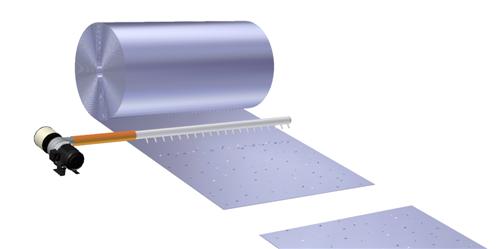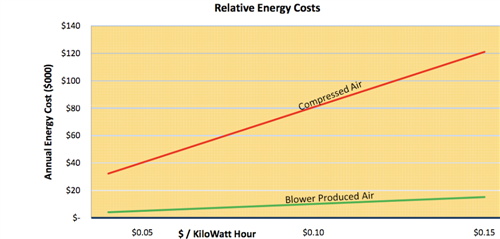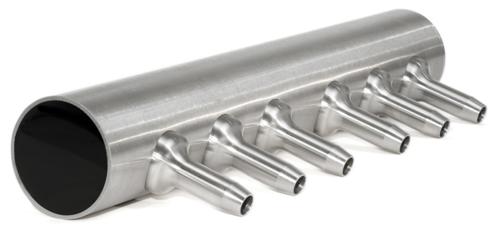Relatively few people realize that for a variety of industrial manufacturing applications, from air knife drying to simple blow-off nozzles, the use of high pressure compressed air that bleeds into the atmosphere represents a significant waste of energy. This is confirmed by the DOE’s Compressed Air ChallengeÆ, calling it “an inappropriate use of compressed air.” This costly waste of energy can be eliminated by replacing the use of compressed air with lower-pressure, high-velocity air. Beyond providing industrial process air at a fraction of the cost, high-speed blowers generally provide better results in drying and blow off situations.
Problem
A major US manufacturer of light gauge aluminum decided in 2006 that it had to address the efficiency of its energy use in its main manufacturing plant in western Tennessee. They found in their audit that one of the main culprits was the unrestricted and unmonitored usage of compressed air at the aluminum foil casting stations. The casters utilize a horizontal, continuous casting method, in which two large rollers compress a feed of molten aluminum into a 0.200” thick sheet. As the sheet cools, a jagged, irregular edge is left on the sides. A rotary mill on each side removes the rough portions, creating a smooth, straight edge to the sheet. Most of the metal chips created by the milling fall to the floor. However a significant amount falls back onto the sheet. Later, the sheet is rolled into 6-foot diameter spools. If these chips are not removed the aluminum will be damaged, causing rejects by their customers’ quality control departments.
 |
||
| Aluminum Foil Casting Stations Require Blow-off Air to Remove Aluminum Chips |
To remove the chips, the plant was using a series of Lechler multi-channel, flat fan nozzles attached to º” feeds from the plant’s compressed air line. The pressure and flow was measured at each nozzle to be 7.7 CFM at 87 PSI. Assuming 4 CFM per kW, it was determined that the plant was requiring 96 kW for each of its four casters to remove the metal chips from the surface. Operating 24 hours a day, 350 days a year, the total energy usage is 804,300 kW-hrs per year per caster. At a rate of $0.046 per kW-hr and with maintenance costs, assumed at 10% of the total energy costs, the plant was spending $40,698 a year to remove the chips from the aluminum at each of four casting stations.
 |
||
Solution
The plant engineer contacted JetAir Technologies about the possibility of using a high-speed centrifugal blower to replace the compressed air nozzles at the aluminum casting mills. JetAir applications engineers visited the plant and determined that the metal chips could be removed with the use of a high-speed blower. “A lot of people think that you need the high pressure of compressed air for blow-off applications,” says Dan Snyder, VP of Engineering at JetAir Technologies. “However, pressures around 80-90 PSI are in fact overkill and far too costly to produce.”
Nearly every industrial application using high-pressure compressed air that bleeds into the atmosphere can be accomplished far more efficiently and effectively by the proper combination of high flow rates and moderate pressure. The JET-3 blower uses direct-drive construction and VFD technology to operate at speeds up to 20,000 RPM, creating flow rates upwards of 1,000 CFM at pressures of 1.5 to 4 PSI. Rodney Campbell, owner of Velocity Industrial LLC (Rockwall, TX), reports, “I have replaced many compressed air applications in plants across the southwest and the people there are generally amazed at how effective these high-speed blowers are. The increased performance and significant energy savings create an ideal combination that can’t be denied.”
JetAir engineers designed a custom solution for the aluminum plant based around the JET-3 high-speed blower. To replace the Lechler nozzles, JetAir designed a custom JetBlast nozzle manifold. The JetBlast was constructed out of rugged 304 stainless steel and featured twenty _” ID nozzles at 2.5” spacing. JetAir engineers and test technicians determined that each nozzle needed to produce 30 CFM at 2 PSI to easily remove the chips from the surface of the aluminum sheet. To do this a 15HP model of the JET-3 was chosen to provide the air for the JetBlast.
 |
||
| A JetBlast Nozzle Manifold |
After testing this configuration, the JetAir engineers found that the highly efficient design and construction of the JET-3 allowed for a true energy consumption of only 13HP, or 9.7 kW. This represented a dramatic 90% decrease in energy usage at the casting stations. Based upon the aluminum plant’s production cycle and kW per hour rate, the JET-3 solution was determined to have an operating energy cost of only $3,750 per year, a total savings of almost $37,000 per year at each caster. These cost savings would pay for the entire JetAir system, including one year maintenance and installation, in only 4.6 months and create a simple one year ROI of 264%.
Results
The aluminum manufacturing plant was initially motivated by the dramatic reduction in energy costs the JetAir system would create. After installing the system, the plant was surprised at how well it worked. “We were impressed by what this blower-based system can do. We like the JetAir blower system so well, we bought three more for our other casting lines,” says Brian Odom, Plant Engineer.
In this time of rising energy costs and increased concern about the environmental impact of manufacturing processes, it is more important than ever to address the wasteful use of compressed air in inappropriate industrial applications. High-speed centrifugal blowers represent not only an effective, green alternative to compressed air but also mean increased savings in energy consumption and ultimately a better bottom line for industrial manufacturers.
For more information please contact Brendan Smith, JetAir Technologies.



